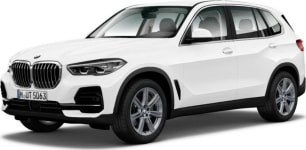Few SUVs are as imposing as the X5 xDrive30d. Simply put, it commands attention on the road, or even from across the road. Or a mile away.
The sense of commanding presence starts at the front, where the first signs of its sports body kit are. As impressive as the trio of large air intakes is, it’s the engorged version of BMW’s signature kidney grille that gets people talking. It’s simply appropriately sized for a vehicle this big, if you ask me.
The adaptive LED headlights integrate hexagon-style daytime running lights, which look the business, while the LED foglights below also help to light the way.
Around the side, the X5 xDrive30d is also pretty slick, with our test vehicle’s optional bi-colour 22-inch alloy wheels ($3900) filling its wheelarches nicely, with blue brake callipers tucked behind. The ‘air curtains’ also look sporty alongside the high-gloss Shadow Line trim.
At the rear, the X5’s three-dimensional LED tail-lights look superb, combining with the flat tailgate to deliver a strong impression. Then there’s the chunky bumper, with dual exhaust tailpipes and a diffuser insert. Not bad at all.
Step inside the X5 xDrive30d and you’d be excused for thinking that you’re in the wrong BMW. Yes, it could very well be a body-double for the 7 Series luxury sedan. In fact, in many ways, it’s just as luxurious as BMW's flagship model.
Granted our test vehicle had optional Walknappa leather upholstery covering its upper dashboard and door shoulders ($2100) , but even without that it is still a seriously premium affair.
Vernasca leather upholstery is the X5 xDrive30d’s standard choice for seats, armrests and door inserts, while soft-touch materials are pretty much found everywhere else. Yep, even on the door bins.
The ambience is further heightened by the Anthracite headliner and ambient lighting, which makes things feel even sportier.
Speaking of which, while it might be a large SUV, the X5 xDrive30d still has a genuinely sporty side, as exhibited by its chunky steering wheel, supportive front seats and grippy sports pedals. They all make it feel that bit more special.
The X5 also has cutting-edge technology, highlighted by the pair of sharp 12.3-inch displays; one being the central touchscreen, the other a digital instrument cluster.
Both are powered by the now-familiar BMW OS 7.0 multimedia system, which was a stark departure from its predecessor in terms of layout and functionality. But that’s no bad thing, as it still raises the stakes, especially with its always-on voice control.
Users will also be stoked by this set-up’s seamless support for wireless Apple CarPlay and Android Auto, with the former connecting with ease upon re-entry, although it does consistently dropout if the iPhone involved is placed in the cubby directly beneath the dash...
That said, the instrument cluster is fully digital, having abandoned the physical rings of its forbear, but it looks dim and still lacks the breadth of functionality that some rivals offer.
And let’s not forget the brilliant windshield-projected head-up display, which is large and crisp, giving you few reasons to look away from the road ahead.

































